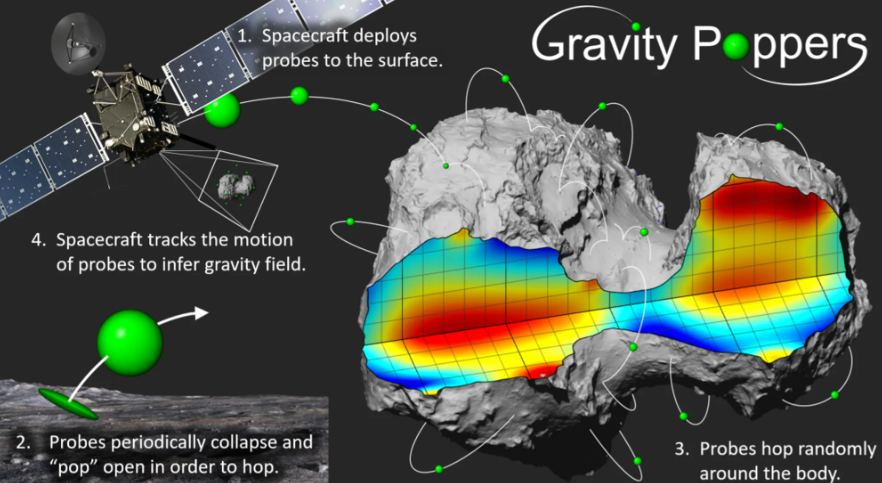Recently, there has been an increase in missions targeting small bodies in the solar system. OSIRIS-Rex, Psyche, and Rosetta are all examples of projects that are planning or actually rendezvous with small bodies in the solar system. But one of their biggest challenges is understanding the gravitational pull of these objects – which was especially evident when the Rosetta lander Philae had trouble staying on the surface of its intended comet. A new idea from researchers at the University of Colorado Boulder and NASA’s Jet Propulsion Laboratory could help solve this problem — by bouncing a small probe.
The concept, called Gravity Poppers, grew out of a 2020 NIAC grant. The idea is simple – release a bunch of probes onto the surface of a small object and have them jump off periodically. When they do, track them. If you know the force with which they jump, and can track them as they return to the surface, you can estimate the gravity in the area where they float more accurately than other techniques.
Scientists use three main alternative techniques to calculate the gravity of small objects—radar tomography, seismic imaging, and gravity measurements. Each has drawbacks that Gravity Poppers can overcome.
Image source – Ben Hockman YouTube channel
Radar tomography uses reflections of radio signals to estimate gravity conditions in a specific area. However, penetrating deeper into the small body is difficult. Some materials do not reflect electromagnetic waves at all, so areas cannot be characterized with these materials.
Seismic imaging is widely used on Earth. By tracking the movement of seismic waves across an object’s surface, scientists can estimate the gravity of the area surrounding the object. However, some small bodies, especially asteroids, are just piles of rubble without an internal coherent structure. Seismic waves don’t perform well in such an environment. The asteroid Ryugu visited by Hayabusa2 absorbed the seismic energy of the impact so much that the spacecraft couldn’t even discern any changes in its surface features.
Gravity measurements are the simplest of the three techniques and require the least equipment on board the spacecraft. How does this small body pull on the spacecraft orbiting it? Does gravity increase or decrease as it passes through different areas? However, measuring gravity from a distance is not easy because orbits tend to be relatively far away. Therefore, the accuracy of this technology is relatively low.
Enter gravity popcorn. An orbiter could release dozens of such objects—a paper detailing the idea suggests 20. When they land on the surface of an asteroid, comet or small moon, they occasionally use internal force to jump off the surface, but not enough to lift them off the surface. Break the bonds of gravity. Depending on the target area to be studied, they can be done at an angle or vertically.
As they fly away from the surface, orbiting motherships track them and calculate their trajectories, which can then be used to calculate the gravity of the area they fly through. They then land, reset, and repeat with the orbiter tracking them. The team studied two types of popper structures: spheres and cubes. They chose a cube that also had LEDs embedded in it to create a light source that the orbiter could track.
However, it’s not as simple as tracking the light source – a lot of system dynamics involves calculating the trajectory angle, the force of the Popper jump, and the landing position. The paper also details how modeling software developed by NASA can be used to simulate the actual operation of such a mission.
Unfortunately, this means there aren’t any prototypes yet. As of now, it has not received the second phase of NIAC funding. But the idea is so unique and simple that with a little development effort, engineers may be able to master this novel approach to exploring some of the most economically and scientifically interesting worlds in the solar system.
learn more:
Vera et al. – Estimating the gravity of small celestial bodies through optical tracking of jumping artificial detectors
UT – As an asteroid approaches Earth, we have a rare opportunity to learn about its composition
UT – How to make asteroid landings safer
UT – Spacecraft could use gravity to prevent dangerous asteroid impacts
Main image:
Artist’s rendering of the Gravity Poppers mission concept
Photo credit – Benjamin Hochman
#Tiny #jumping #robot #study #asteroids #gravity
Image Source : www.universetoday.com
